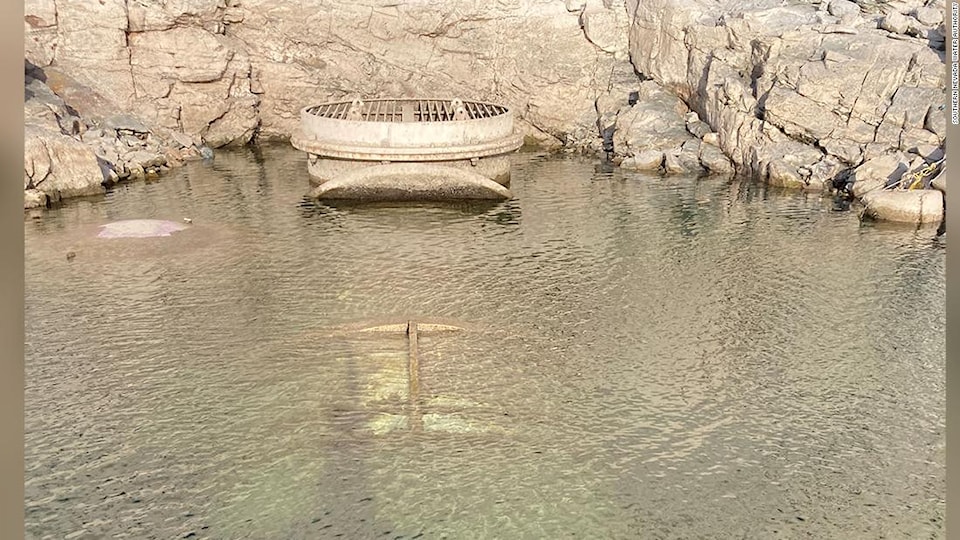Las Vegas is a popular tourism mecca for B.C. residents.
But beyond the casino glitz and glamour, how that city, one of the fastest growing in the U.S. for many years, is dealing with the necessities of water conservation offers a lesson to Okanagan Valley residents in the short-term future.
No new golf courses banned new water features on the Las Vegas Strip, residential pools restricted to a maximum of 600 square feet, a moratorium on water-based evaporative cooling in commercial developments, no watering for non-functional grass outside of schools, parks and cemeteries, prohibiting the planting of new grass while encouraging the planting of new trees to provide a more natural shade canopy.
Explaining the impact of these measures was Zane Marshall, director of water resources for the Southern Nevada Water Authority, who gave a keynote address at the annual general meeting of the Okanagan Basin Water Board on Friday at the Rotary Centre for the Arts.
Marshall talked about the impact of climate change, of extreme weather events combined with hotter temperatures, reduced precipitation and snowpack runoff on the Colorado River Basin, known as the world's most controlled and litigated river system.
Marshall drew upon comparisons to the Okanagan and Colorado basins sa���ʴ�ý� a growing population, strong tourism sector, and water scarcity issues made worse by climate change, including shorter winters with less precipitation.
"Our water supply is changing and we have had to change," he said, saying that after 25 years of dwindling water supplies "we're not calling it drought anymore, we're calling it long-term aridification."
The Colorado River Basin is currently at the centre of a debate over water use, with political quarrelling taking place over the control of its valuable water resource that serves some 40 million people in seven states along with five million acres of farmland, 30 Indigenous tribes and two states in Mexico.
Agriculture uses about 80 per cent of the Colorado River's water to irrigate 15 per cent of the U.S. farmland and produce 90 per cent of the winter vegetables.
Marshall said the original water sharing agreement dates back to 1922, which allocated too much water, and despite the environmental changes and regional population growth that has occurred in the years since, with the exception of minor modification updates the original agreement largely remains in place.
"A 2022 Drought Response Operation Agreement modifies lower and upper water basin controls for the Colorado River system is set to expire in 2026 and negotiations are being carried out today to reach a new goal. But there is still a lot of work to be done in reaching that agreement," said Marshall, noting conflicting self-interests between domestic and agricultural use, complicated by urban population growth across the U.S. southwest, are making compromise difficult to arrive at in those negotiations.
Marshall said that the Southern Nevada Water Authority, recognized back in 2003 the water supply challenges in their region by a dwindling Colorado River reservoir system and the declining depth of Lake Mead.
Currently, about 40 per cent of the water used from Lake Mead for domestic use is treated and returned to the Colorado River Basin system for re-use, the other 60 per cent is lost to outdoor water use evaporation.
Since then, the authority has included drilling a tunnel to lower the water intake level if Lake Mead continues to drop further, creating an aquifer to bank water supply equal to 12 times the average annual water supply demand, and adopting water conservation measures.
"We are trying to find a balance between reducing our water demand while accommodating a growing population base," Marshall said.
The results so far on the water conservation effort have been positive. Dating back to 2002 the Southern Nevada population has increased by 52 per cent while water consumption has dropped by 25 per cent, much of that over the last two years since the conservation measures were adopted.
"The lesson we have learned is the time for us to act is now. Policy debates take time to work out all the issues," he said.
"No one entity and no one solution can solve it typically. Working together is important as is public input.
"And, if you think you need to take action, you probably should have started yesterday. Act now to put things in place because policy takes time, action takes time and funding takes time."
In a question and answer session following his presentation, Marshall was asked why he made little reference to agricultural water use in his presentation.
Marshall noted agriculture use is a huge issue across the Colorado River Basin system, but for southern Nevada, the dry climate and geography limit its water use impact.
Marshall was also asked about rising hydropower energy costs as a result of water conservation measures, a relationship that he acknowledged exists but that ongoing research is attempting to address.
"We had a lot of pushback from the Las Vegas hotels about moving away from evaporative cooling to other mechanical cooling options but research is ongoing to develop new air circulation and cooling strategies," he said.
"But these are hard decisions we face in order to do the right thing."



